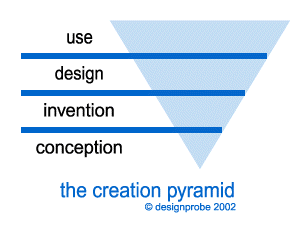|
 |
The Creation Pyramid
In The Levels of Creation we considered four different levels at which creation occurs. In this article we model this as The Creation Pyramid.
The Creation Pyramid is a representation of the four levels of Creation. The pyramid as a form has been selected because it has the following implications for this model…
The Pyramid
Firstly, whilst it is drawn as a two-dimensional triangle, the naming of it as a pyramid infers the three-dimensional, holographic nature of conceptual frameworks and their impact on our lives. One conceptual framework may become the basis for many forms of technology that may not at first inspection appear to be connected. This gives rise to a generation of designs that shape the objects we use and consume in our daily lives.
Holographic
The properties of a hologram are unique in that when any one piece is broken from the whole, each piece retains the overall configuration simply with a smaller viewing area. For example, if a hologram of a face is broken in half, the face remains in tact and you are left with two smaller holograms each expressing the same face albeit at half the scale of the whole.
In this case this reflects the qualities of the other levels of creation. For example, how we use a designed object is always shaped by the thinking that designed it, the technology that made it and the thinking that allowed for that simply to be considered. Whilst we may not be aware of the conceptioning that created it, it is all pervasive, it is always present.
For a more specific example, consider most of our modern buildings. Most were conceived inside a framework of the world developed during the Renaissance. This level of form conception was based upon platonic or regular solids. The most common in buildings is the cube. Our vertical brick walls or timber framing represent technology consistent with this spatial thinking (in other words, they let us build our cubes!). Our designs, regardless of the personal intentions of the architect or designer, reflect this. This is further demonstrated in our daily living inside our ‘boxes for living in’ through the placement of our furniture in the corners and along the walled edges. In this way, regardless of the work of the designer, we are conditioned by the spatial conceptioning of the Renaissance and we grow to presume that ‘cube is it’. We most definitely don’t walk around saying ‘Those Renaissance guys…’, for the most part this is quite unknown or at least completely transparent to us.
The Point
The pyramid is represented in four layers corresponding to the four Levels of Creation.
As in the case of bricks holding up a wall, there is a degree of corbelling. The top layer of bricks are able to stretch out over the edges of the ones below due to the overwhelming strength of the forms below.
Each layer below has the strength to support the layers above.
The Base
At the base is ‘conception’. The whole pyramid rests upon the sturdy point of a conceptual framework. In other words, the worldview, the paradigm, the framework for looking at the world is what supports everything else. ‘Technology’ is then created based upon this framework, ‘design’ is then created out of what is possible inside our technological capabilities and on top is the consumption and ‘use’ of the designed objects that form the vast majority of our daily interaction.
The ‘conception’ triangle is clearly the smallest group and the ‘use’ is the largest. This also points to the amount of work that is being done in each of these domains. Relatively few people on the planet are engaged in the level of conceptual creation that could impact the future thinking of the whole planet whilst we all engage in the domain of ‘use’ each and every day in so many ways.
The Balancing Point
The balancing point of the pyramid is contrary to the constructions of the great Egyptian builders. Their pyramids were built on a solid base with the intention of standing the test of time.
In contrast, the Creation Pyramid balances precariously on its point waiting for new evidence or new thinking to tumble it to the ground in preparation for the building of a new pyramid.
Perhaps the most famous paradigms to tumble in the past few centuries include:
• the shift from a flat earth to being on a spherical planet;
• the shift from the earth being the centre of the universe to being a mere planet orbiting one sun in a galaxy of starts; and
• Darwin’s Theory of Evolution and the overturning of the notion of the separation of humans from our fellow animals.
Other Articles in this series:
• Inventing Creation: The link between biotechnology and the Age of Creation
• The Levels of Creation: Creation occurs at four distinct levels
• Longitude: Four articles based upon Dava Sobel's book 'Longitude' telling the story of John Harrison, inventor of the chronometer.
|
 |
| |
|
|

|
|

